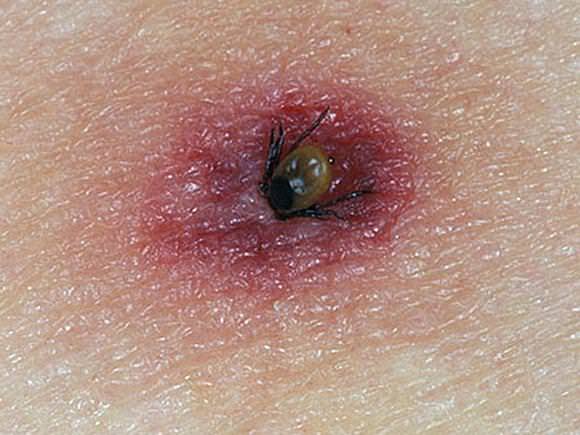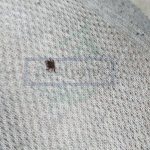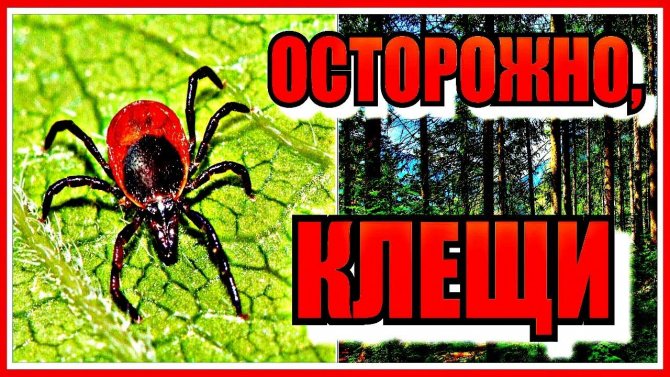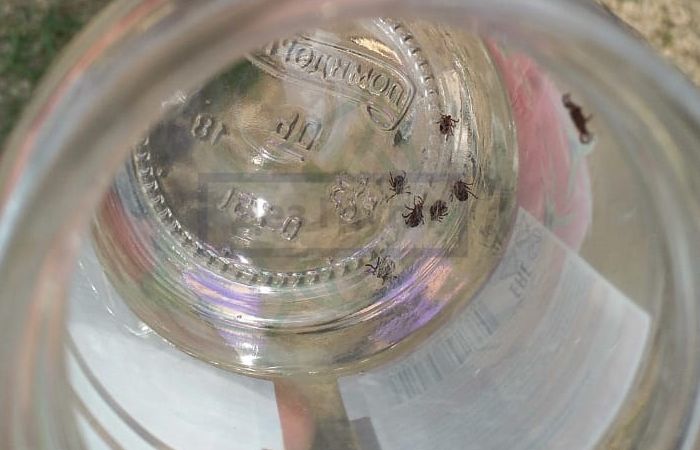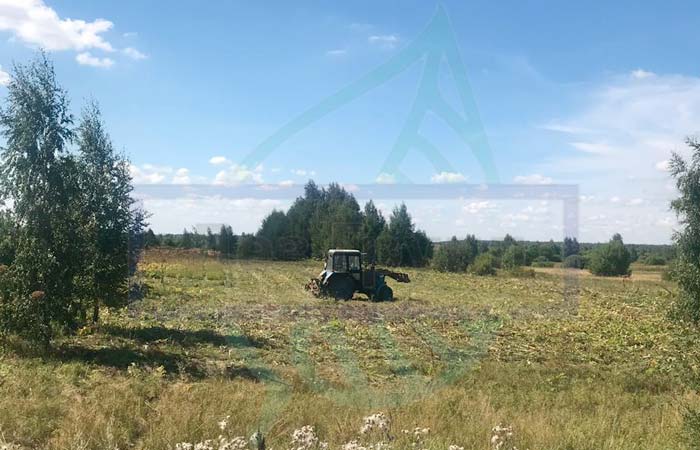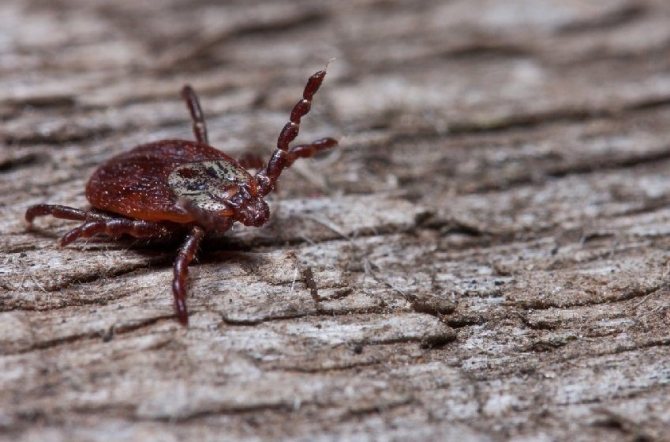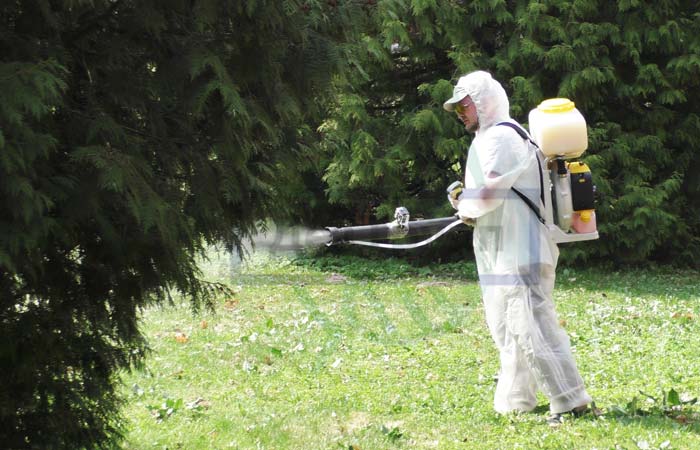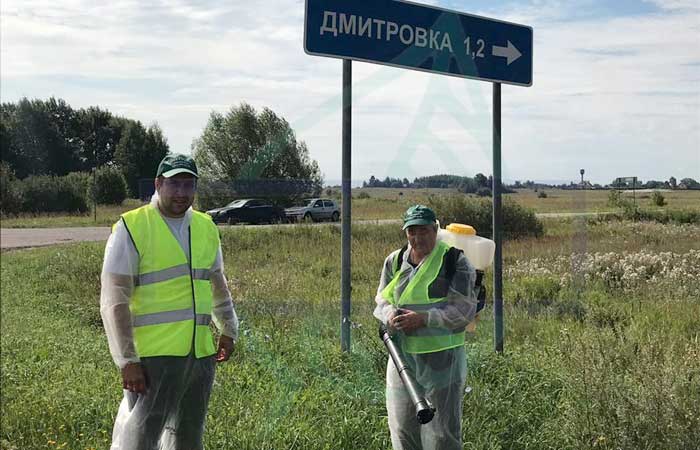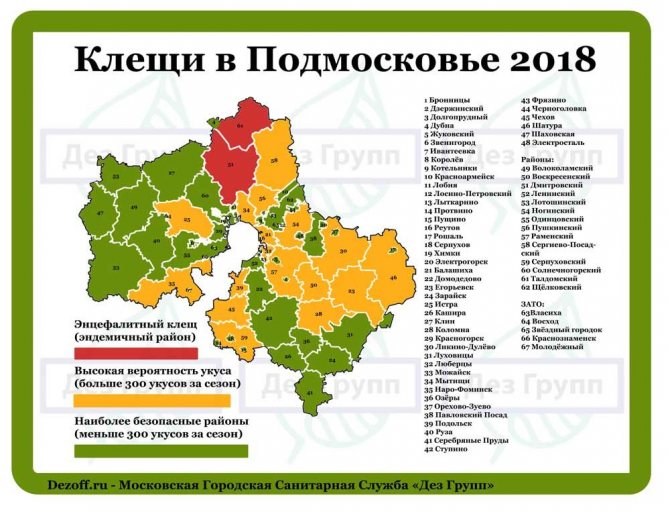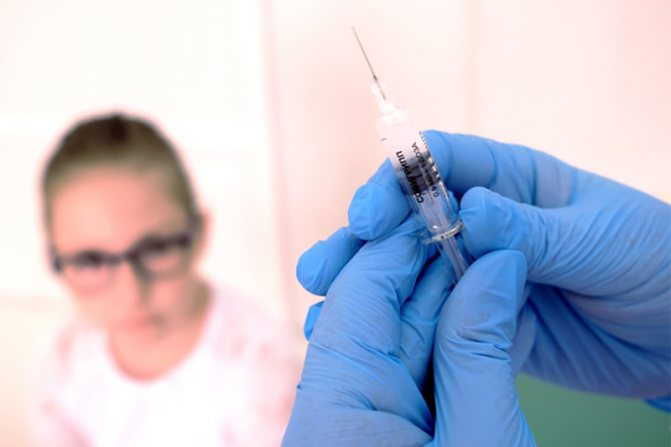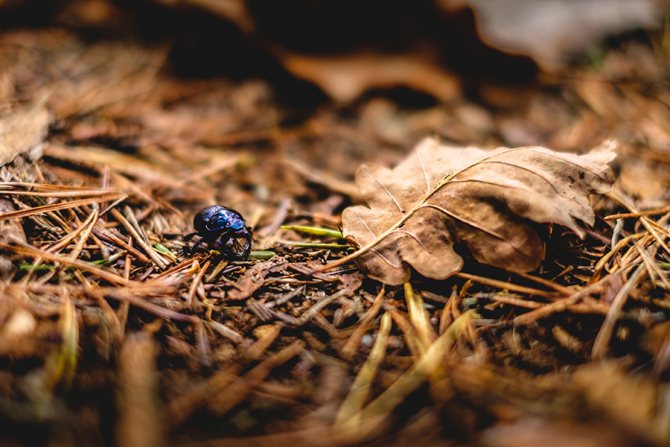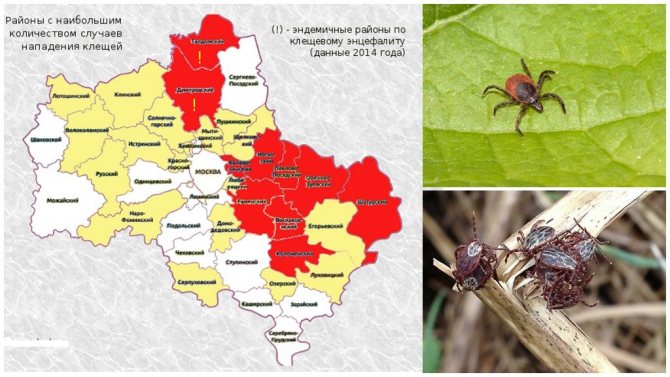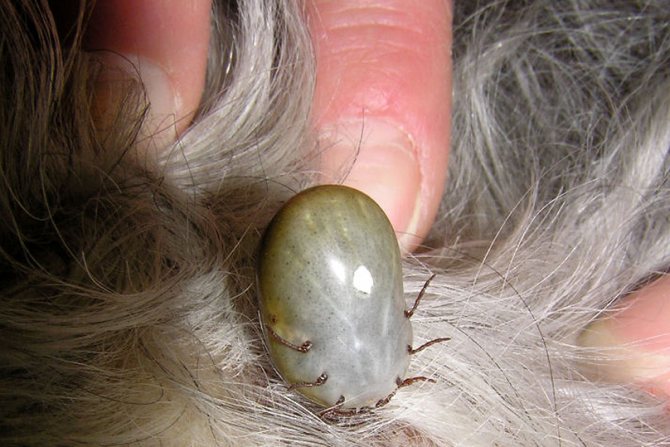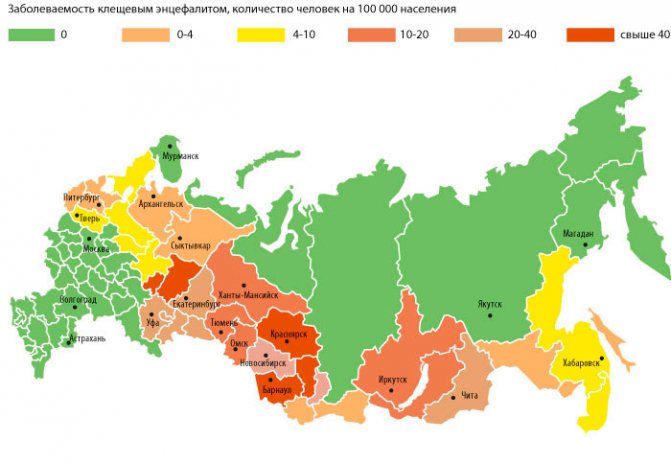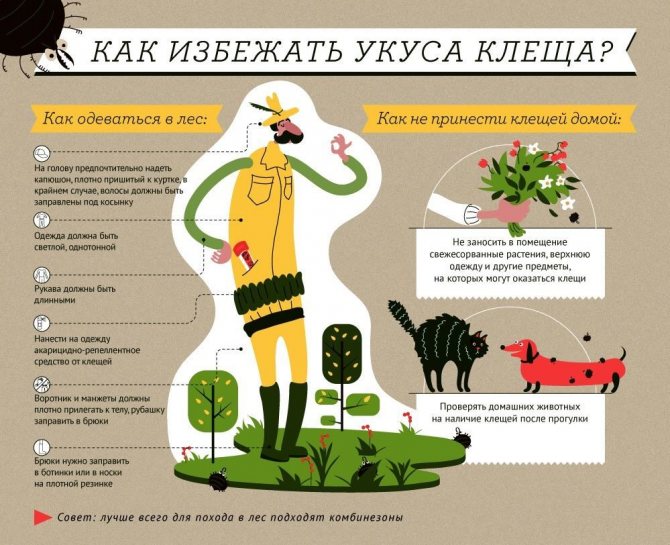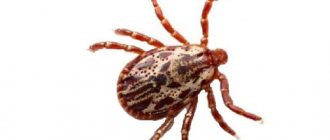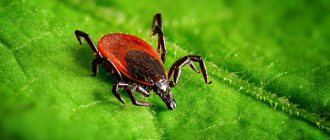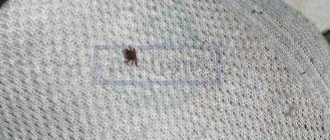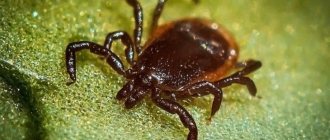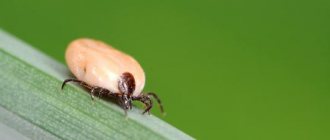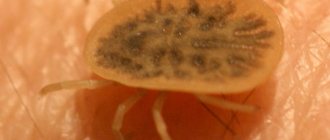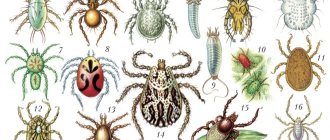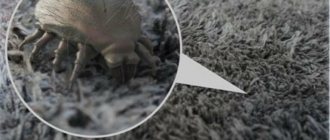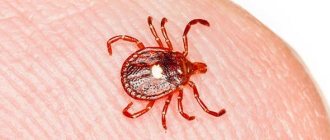In the spring, as soon as the snow melts and a predominantly positive air temperature is established outside, ticks are activated everywhere and go hunting. Now they can be easily found both on dry grass and on any vegetation, mainly along paths and animal paths. However, they are almost everywhere: in the fields, along the banks of reservoirs, in the forest, and even at their summer cottage. Moreover, it is not necessary to go to the garden. There are often cases when ticks come across right on the doorstep of the house.
Ticks in the Moscow Region 2020: when does tick activity begin
When winter ends and the snow begins to melt, ticks awaken in nature. The peak of tick activity occurs from April to October.
The most favorable conditions for the activity of ticks is a positive air temperature, especially when the thermometer shows from +18 to +20. The active phase in the hunting of ticks begins at the end of April. They begin to come out of hibernation, actively reproduce and hunt. In June, most ticks die due to hot weather. The second phase of activity begins at the end of August. If autumn is warm, then the tick is in no hurry to hibernate, however, if cold weather comes in September, then you should not be afraid of ticks. A tick bite can overtake a person anywhere. Most often, arthropods live in forest areas or a forest park area.
For walks in the forest, you should wear closed clothes, preferably with your neck covered. Jacket sleeves and pants should be long. It is also best to wear high-waisted shoes. For recreation in the forest, you should choose an open area without large thickets. Before going to bed, you should examine yourself and others for tick bites.
At home, you should separate your clothes for hiking in the forest from your everyday clothes so that ticks cannot transfer to them. A good way to protect yourself from arachnids is to treat clothes with acaricidal agents.
If a tick has bitten a person, you should immediately remove it with a thread or other veterinary device. It is worth trying not to kill the tick inside the skin, but to extract it alive and deliver it to the laboratory for research on the presence of diseases.
Tick season 2020
If the tick does not die for reasons beyond its control, then it can live up to 8 years. This means that in the conditions of the climate of the Central region of Russia, it must winter somewhere. In autumn, mites burrow into the upper layer of humus, withered grass, crawl under the bark of trees, where they fall into suspended animation. In spring, weather conditions serve as a signal to get out of hibernation. It depends on them when the tick season begins in 2020. To awaken ticks, it is necessary that:
- The snow has melted.
- A stable temperature is established above + 10 ° C.
Tick awakening is gradual and geographically uneven. On thawed patches heated by the sun, ticks can wake up much earlier than the official start of the tick season for a particular area. This explains the early appearance of the first reports of parasite bites.
How do you know if the ticks are awake?
To find out if the ticks in your area are awake, take a white piece of cloth the size of a hand towel and run it along the ground or first greenery where the insects may be suspected.If the ticks wake up, several individuals are likely to end up on the matter. In the original version of this method, it is recommended to use a waffle towel worn on the shaft like a flag, but you can limit yourself to any fleecy cloth that the insect can catch on to.
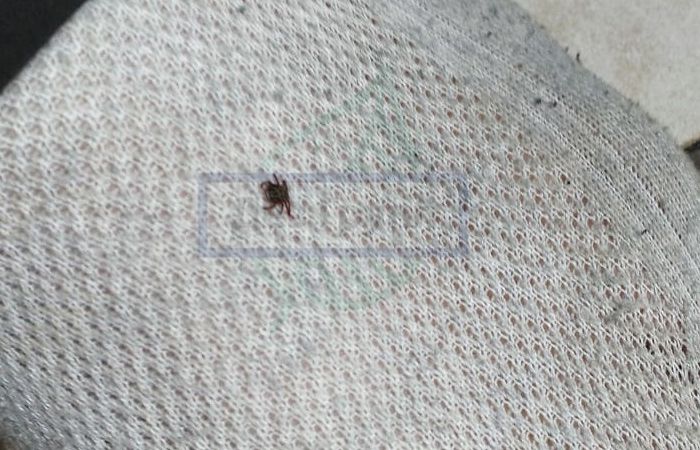
If you do not want to experiment on your own or are interested in a purely theoretical question, the easiest way to find out about the awakening of ticks is to look through the local media or your regional Rospotrebnadzor website for the first reports of bites.
Helpful advice
The most unwanted way to know if ticks are awake is to be bitten. If this is the first time this season you go to the country and plan to work in the garden, even if there is still snow in some places, be sure to apply a tick repellent to your clothes.
The first days and weeks after the snow melts before the start of intensive plant growth is the best time to bait ticks on the site. The treatment carried out at this time suppresses the surge in the activity of parasites at the initial stage, preventing them even from waking up completely. In order to make it or order it at the SES, it is not necessary to check whether the ticks are active. Enough for all the snow to melt.
Recommended links
Professional elimination of ticks in summer cottages and territories for any purpose.
FORESTS WON'T TOUCH
The forests of the region will not be treated against ticks. This was reported by the press service of the Forestry Committee of the Moscow Region.
“The forests near Moscow are protective, they are designed to help the metropolis with their naturalness. Therefore, the Forest Code of the Russian Federation prohibits the use of toxic chemicals on their territory that can cause chemical damage and poisoning of a person both during his stay on his territory and as a result of the use of his resources, such as mushrooms and berries, ”the regional department explained.
In this regard, experts recommend, going into the forest, to observe the rules of individual safety: dress in tight, closed clothing, treat it and open areas of the body with special repellents.
WHERE AND WHEN
Currently, preventive treatment of trees and lawns has already taken place in Shchelkovsky, Zhukovsky, Dmitrovsky, Naro-Fominsky, Yegoryevsky and Krasnogorsky city parks, as well as in the Verbilki park of the Taldom district.
- Each municipality and park independently determine the time of sanitation, if necessary, the procedure can even go through twice, - said the press service of the Ministry of Public Improvement of the Moscow Region. - But at least once from April 15 to May 15, during the period of special activity of ticks, all park areas of the Moscow region will be processed.
IMPORTANT!
The processing of park zones in the region began on April 15 and will take place until May 15.
Lyubertsy - a cluster of factories and dumps
Breathing in the city is even harder than in Moscow. The local economy is developing thanks to industrial production, which is very closely related to the emissions of harmful substances and waste into the atmosphere. There are several large enterprises producing building materials, technical equipment, and a helicopter plant.
The largest waste incineration plant in the country is located on the territory of the city, in the industrial zone of Rudnevo. Another such enterprise is "Ecolog", where they used to incinerate the corpses of sick animals, biological remains from numerous medical institutions in Moscow. There is in Lyubertsy the largest aeration station, on the fields of which the Moscow sewage system has been discharged for decades. The station has not been used for a long time, it is impossible to close it, and the land is contaminated with heavy metals, hazardous chemical waste. Residential buildings were built on some of these fields, where today it is not easy for people to live - methane accumulates in the basements.The wind brings unpleasant odors from the former station.
All this together leads to general soil pollution in the city, diseases of trees and plants, and gradually local water bodies become unsuitable for swimming. Even the children here know that you cannot feast on fruits from the trees growing near the houses, because you can simply get poisoned. Things are going badly with garbage removal and street cleaning.
BTW
You can get vaccinated against tick-borne encephalitis. But this must be done in advance - at least 1 month before visiting the dangerous territory. In addition, immunity is developed only after a course of two vaccinations, between which at least a month must also pass. Free vaccination under the compulsory medical insurance policy is provided to those who are at risk due to being in dangerous territory or on duty. You can find out who and how can get vaccinated, including for encephalitis, by calling the free round-the-clock telephone of the Unified Consulting Center of Rospotrebnadzor: 8 (800) 555-49-43. Against another dangerous disease transmitted by ticks - borreliosis, we recall that vaccinations do not exist.
In which areas of the Moscow region are ticks most active in 2020?
The first tick bites in 2020 were recorded in March in Solnechnogorsk, Lukhovitsky, Shakhovsky and Zaraysky districts. There were no cases of infection with encephalitis or borreliosis. Ticks in the Moscow region rarely carry encephalitis, mainly they carry Lyme disease and tularemia. Get vaccinated against tick-borne encephalitis if you plan to travel to a potentially encephalitis-prone area. Last year, more than a thousand people voluntarily underwent such a procedure and secured themselves in advance.
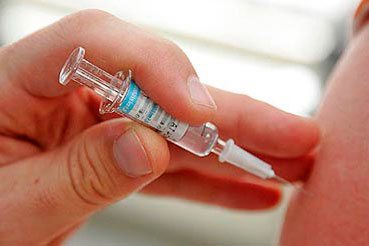

In almost all areas of the Moscow region, there is a threat of infection with borreliosis (Lyme disease) from the bite of an ixodid tick. The infection map of the Moscow region warns that in 2018 the most dangerous areas are: Taldomsky, Dmitrovsky, Istrinsky, Voskresensky, Volokolamsky, Shatursky, Lukhovitsky, Yegoryevsky, Domodedovsky, Ramensky, Noginsky, Pavlovo-Posadsky, Ozersky, Orekhovo-Zeuvsky, Ruzsky, Lyuberetsky Naro-Fominsky, Ruzsky, Pushkinsky, Kolomensky, Serpukhovskoy, Stupinsky, Solnechnogorsky, Khimkinsky, Lotoshinsky, Klinsky, Shchelkovsky, Mytishinsky, Krasnogorsky.
The most disadvantaged areas at the moment are Dmitrovsky, Taldomsky, Shatursky, Kolomensky, Noginsky, Orekhovo-Zuevsky, Pavlovo-Posadsky, Balashikhinsky.
Although Moscow parks are treated against ticks, there is still a risk of encountering a tick in a city park or public garden. Check yourself and your pets after the walk. Mites like to stick to the back of the head, neck, axillary and groin areas.
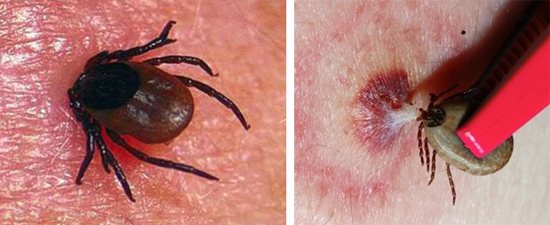

At the end of August 2020, appeals to emergency rooms and other medical institutions were recorded regarding tick bites in the following unsuccessful tick-borne areas:
- Ramensky district - 485
- Dmitrovsky district - 465
- Kolomna - 432
- Lyubertsy - 424
- Serpukhovsky district - 423
- Balashikha - 412
- Noginsk district - 368
- Orekhovo-Zuevsky district - 310
- Naro-Fominsk district - 299
- Sergiev Posad district - 274
- in other municipalities, 20 to 200 cases were reported.
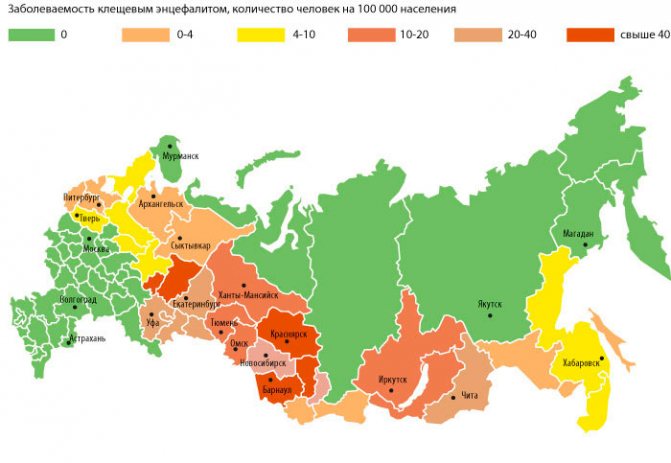

Tick-borne encephalitis endemic areas 2020
Tick-borne encephalitis is a viral infection that attacks the nervous system of the body, affecting the brain and spinal cord. The damage that a virus can cause depends on the extent of the damage to the nervous system. In 25-30% of cases, encephalitis leads to the death of the infected. The disease is extremely dangerous not only for people, but also for dogs
.
A list of areas of the country where encephalitis ticks are found is compiled annually, based on data from the previous season. At the same time, the geography of the spread of parasites infected with the virus practically does not change from year to year, which is why the endemic areas for tick-borne encephalitis in 2020 will remain approximately the same as in past seasons.
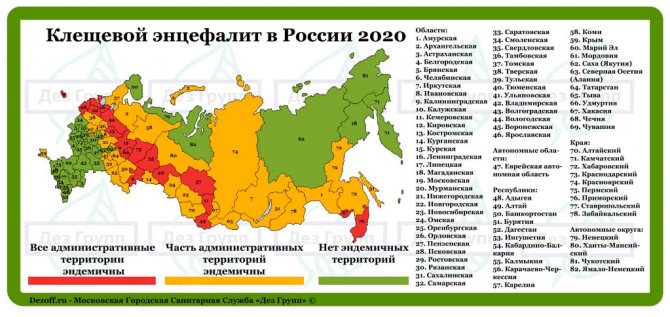

Detailed list of endemic territories of Russia for tick-borne encephalitis
posted on the Rospotrebnadzor website.
Caution!
Even if the territory is not endemic for encephalitis, ticks living on it can be carriers of any other infections.For example, borreliosis and hemorrhagic fever are transmitted to humans 3.5-4 times more often than encephalitis - about 6-7 thousand cases of infection with these diseases are recorded annually against 1.5-2 thousand encephalitis.
Prevention and protective measures
To reduce the risk of Muscovites and residents of the Moscow region being bitten by a tick, parks are being treated against ticks in Moscow in 2019. Specialists from sanitary and epidemiological stations are sent to squares and parks to destroy "unwanted guests" with the help of special chemicals.
To protect yourself from the possibility of contracting encephalitis, you can use a special vaccine. It is necessary to put this vaccine until the moment when ticks appear in the suburbs. The vaccine is given in two stages: the first injection is given 2-3 months before the ticks start biting - in November or December. Then the second vaccination is given in 1-2 months. And only after it, two weeks later, immunity begins to act. The third injection is given after 12 months, then the vaccine is repeated every three years. Vaccination against tick-borne encephalitis in Moscow is carried out in budgetary, commercial clinics.
The situation with ticks infected with an equally destructive infection with borreliosis is worse - there is no vaccine against the infection. In case of infection, antibiotic therapy is performed. To prevent bloodsuckers from biting a person, you need to dress appropriately for a walk in the forest or park:
- choose closed clothes with long sleeves;
- tuck pants into socks, a jacket or shirt into pants;
- collect long hair in a ponytail or braid and wear a hat;
- wear plain, light colored clothing, which makes it easier to catch ticks.
Also, special acaricidal agents in the form of aerosols will help, which scare off bloodsuckers. It should be remembered that after each visit to nature, it is necessary to carefully examine the body for the presence of sucked parasites.
Prevention and remedies against bites
There are many different drugs available to protect against ticks. But in fact, you can protect yourself with well-chosen clothing and effective chemistry. Chemicals are divided into 2 types:
- Repellents - you can spray on the body, but they only scare away, the effect is temporary, some types of parasites may be immune to the active substance and then the result of applying the drug will only be clammy skin and an unpleasant pungent odor. Popular drugs: Taiga, Moskitol.
- Acaricides are toxic substances, they are applied exclusively to clothes (you cannot wear treated fabric on a naked body, only with underwear), paralyze and kill ticks, you need to look for alphacypermethrin in the composition. Examples of effective drugs: DETA, Gardex Extreme for ticks.
The skin and clothing should be processed outdoors, in the case of alphacypermethrin, you must additionally wait until it dries completely (about 30 minutes). It is necessary to decide in advance where the clothes soaked in toxic substances will be stored. Hanging it in a room by the bed is a dubious decision.
Even after using tick repellents, you need to periodically inspect yourself. Indeed, during processing, some area could easily be skipped and there the ticks will crawl unhindered. In addition, some drugs fizzle out rather quickly, so you should read the instructions on the label before buying.
Encephalitis
Encephalitis is a special suit that allows you to maximally protect yourself from mosquitoes and ticks. As a rule, this is a jacket, pants and a hat with a mosquito net. A distinctive feature is the built-in parasite traps that can be impregnated with chemicals. Traps are clothing folds and flaps.


Moving from the bottom up, the mites crawl there and get confused in the padded padding polyester or similar material, and when it is saturated with chemistry, they have to inhale poisonous fumes.After a while, they fall to the ground and die. Some may come back to life over time (especially if the suit is treated with a weak but effective drug).
Traditional methods
If you don't want to mess with chemistry, you can use concentrated liquid food smoke to treat clothes. To do this, pour the contents of the can into a spray bottle and process the clothes. There is no need to build any special illusions about this method, but it should help for a couple of hours.
The rest of the options, for example, with ash or alcohol, can be safely credited to myths. It has been proven many times that if there were cases when drunk or soot avoided bites, then this is rather a pure coincidence.
An alternative format is the so-called “Russian roulette”. When you walk in comfortable clothes, without any chemicals, and the chance of a bite is high enough. To minimize it, you need to tuck your trousers into your socks, inspect yourself regularly and, even before leaving the house, check that there are no holes in your socks and trousers. After all, encephalitis is all great, but in summer, when it is 20-25 degrees Celsius outside, not everyone can walk in a tight jacket and trousers with underpants. It can be compared to wearing a mini-house or a plastic bag - sweat and hail and no pleasure from walking.
Insurance
Currently, you can purchase insurance against a tick bite, which allows you to extract the parasite on preferential terms, donate blood for analysis of infection with borreliosis or encephalitis, and obtain immunoglobulin. Depending on the city, the list of services and the cost of the service change. Estimated price 200-250 rubles.
Insurance companies in Moscow that provide such services:
- Alpha Insurance;
- Sberbank;
- Ingosstrakh;
- Reso Guarantee;
- VTB.
This is never a panacea, nor is vaccination. Doesn't give 100% protection. After all, ticks carry a dozen different diseases, and not every doctor immediately makes the correct diagnosis.
Vaccinations
Vaccination is carried out only against tick-borne encephalitis. There is no vaccine against borreliosis, which can cause paralysis and even death. Recently, ticks have become more and more every year and the popularity of this service is growing. So, for example, in Moscow at the time of May 2020, there are more than 160 medical posts where you can get vaccinated. It costs from 300 to 5000 rubles. The range of prices is due, among other things, to the fact that the vaccine can be both Russian-made and from Switzerland, Austria or Germany.
They are vaccinated twice (in autumn and winter), less often three times. However, this is more true for people living in the northern regions, or if foci of encephalitis infection have been observed in the area of residence.
Why is a tick bite dangerous?
For humans, a bite is dangerous, the result of which can be infectious diseases that damage internal organs. The most formidable of them is tick-borne viral encephalitis.
Tick-borne encephalitis
The opinion of doctors is unambiguous: the consequences of a bite of an infected tick can be damage to various organs and systems of a person: skin, nerves, joints, bones, muscles, cardiovascular system, lungs, kidneys, liver. And the most serious problems are from the bite of a tick infected with encephalitis.
Even with a favorable outcome, if treatment is started on time, the symptoms of a mild degree of the disease completely disappear no earlier than two months, with an average degree of severity, recovery takes about six months, and with a severe form of infection, treatment will take at least two years, experts explain, and with an unfavorable development of the disease in a person, motor functions may be impaired, epilepsy may appear.
Death is also highly possible.
Borreliosis (Lyme disease) also affects the internal organs of a person. At the same time, immunity is sharply reduced. If treatment is not started on time, the disease can become chronic, which leads to serious consequences.
Ehrlichiosis (bacterial) - most often this infection is the source of many pathologies, the work of many internal organs is disrupted.
Human granulocytic anaplasmosis is an acute febrile illness with inflammation of internal organs from the bite of ixodid ticks. In recent years, people have become increasingly infected from them. It turns out that these blood-sucking creatures are carriers of some very dangerous diseases, which also lead to disability and even death. The injured person begins to have a rapid heartbeat, blood pressure drops, dizzy, vomiting ... And the main reason for the development of granulocytic anaplasmosis is considered to be infection of a person with a bacterium.
Fortunately, in the capital, as Rospotrebnadzor reported, this pathogen has not yet been detected in laboratory studies, but other dangerous "gifts" from ticks have been found.
Description and photo
A tick is an arachnid arthropod creature that parasitizes humans and animals. The bite is practically not felt, but the problem is that they are carriers of serious diseases, including encephalitis and borreliosis (Lyme disease), which, if neglected, can be fatal.
Development takes place in several stages:
- eggs,
- larvae,
- nymphs,
- adults.
Not only adult ticks bite, but also a trifle, which is much more difficult to detect. Females, nymphs and larvae drink blood only once during their developmental stage. Only females swell with blood. From the moment of the bite to immersion in the skin, it takes about 1 hour on average.
The larvae and nymphs are the same mites, only much smaller in size. If an adult can reach 3-5 mm, then sometimes specimens of 1-2 mm in size dig in. At the first case of a bite, you may not even understand that it is a tick, because with the naked eye, the legs are poorly distinguishable there. Can be confused with dirt or sore.
What are found in the Moscow region: types and their differences
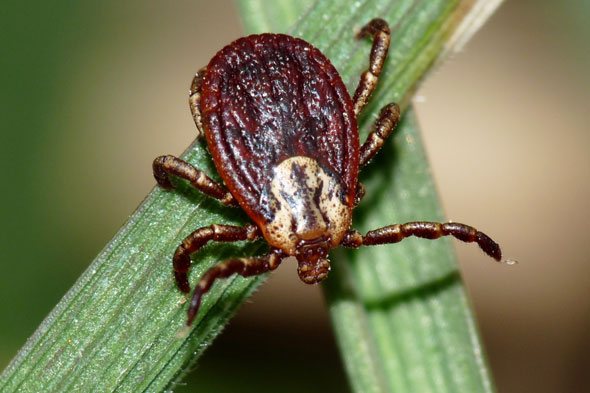

Dermacentor - distinguished by its brown body and rather large size
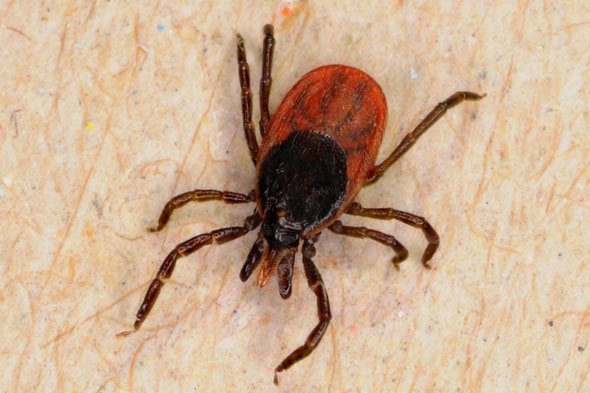

Ixodid (encephalitis) ticks have a pronounced red area on the trunk
In both cases, the photo shows females. Dermacenters are faster and more susceptible to fewer chemicals. It was noticed that with a long stay on the surface of clothing treated with a repellent, such a mite after a while overcomes the sprayed surface and continues to move towards its intended target.
Basic precautions can help you avoid being bitten by encephalitis ticks
Ticks carry about ten types of infectious diseases
Therefore, when going to nature, it is important to prepare for a meeting with dangerous blood-sucking
It is better to wear clothes made of light-colored fabrics to make the ticks more noticeable. Trousers are best tucked into knee-highs or socks. It is advisable to wear a hood, hat or kerchief on your head. Sleeves and collars should fit well to the body. It is advisable to apply repellents to clothing.
It is not recommended to lie down or sit directly on the grass; you need to use treated blankets or bedspreads. It is also recommended to check yourself frequently for ticks.
Favorite places of parasitizing ticks on humans: neck, axillary and groin areas, back of the head. Upon returning home, you need to inspect all items for ticks, without bringing things into the house.
If the tick has stuck to the body. Then you need to remove it as soon as possible using a thread or a special twisting screw. You need to remove the tick with a head. The removed tick must not be thrown away. He should be taken to a laboratory for testing for infections. There are four such laboratories in the Moscow region.
Not every tick in the Moscow region is infected with dangerous infections, and even if an infected tick has bitten it, infection will not always occur. However, if the tick is still bitten, you must definitely contact a doctor. You can also get vaccinated when going to areas where there is a high risk of contracting encephalitis.
US military and borreliosis
Today borreliosis is found in every third tick in Moscow or Moscow Region. And for the first time this diagnosis was made in the 1980s by American doctors. In the small town of Old Lyme, Connecticut, children suffered from arthritis a hundred times more than in other states. And all of them were bitten by ticks. Recently, a sensational investigation was published in the United States: the military was accused of spreading the terrible bacteria.
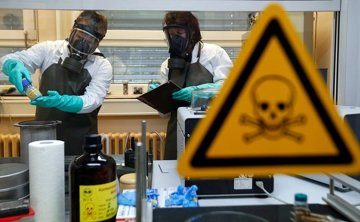

How the United States is spreading bacteriological infection around the world
“We studied how ticks and tick-borne diseases can be used as biological weapons. In some cases, insects have escaped from the laboratories, ”says Chris Newby, a researcher at Stanford University.
Senators are already demanding an explanation from the Pentagon. True, serious scientists question this version. Borellias - caused diseases - appeared on the planet much earlier than humans.
“It's hard for me to say how many million years ago, but it happened a long time ago. Not as a result of some kind of test. This is nature, ”says Natalya Shashina, a leading researcher at the Research Institute of Disinfectology.
BETTER CHECK
The most common tick-borne disease is Lyme disease (it affects the skin, joints, central nervous and cardiovascular systems. - Ed.). In 2020, more than 400 cases of infection with it were registered in the region. If a parasite is found, experts advise you to contact the nearest medical facility, as well as hand over the tick for analysis.
Residents of the region can check whether the insect is a carrier of infection free of charge under the policy of compulsory health insurance. To do this, you need to make an appointment with a therapist, who will give a referral to the nearest laboratory.
“It’s better not to remove the tick on your own,” says Kakhaber Gvazava, head of the epidemiological surveillance department of the Rospotrebnadzor Office for the Moscow Region. - You need to go to the hospital, where it will be done more professionally
It is important to preserve the tick and deliver it to the laboratory. So you can understand if he is a carrier of infection.
How are hazardous areas identified?
Epidemiologists conduct special research. One of the methods is quite simple, but effective: a piece of white fabric is taken, which is called a "flag". With him, specialists move through the forest area, and then count how many ticks hit him. There is even a special unit of measurement - the number of ticks per flag-kilometer.
Then the collected ticks are examined for infection with pathogens. There are different degrees of danger of a natural focus. If a lot of ticks have been collected and among them there is a high percentage of infected, acaricidal treatment is carried out. This is especially true for children's health camps, recreation areas, sanatoriums.
Korolev - green area
The townspeople are lucky with natural resources, there are many forests and rivers in the city, about 33% of the Korolev's territory is occupied by parks, green spaces, squares. The territory of the city includes the Losiny Ostrov National Park, where many different trees grow, birds, wild boars, hares, elks and more live. Trees effectively purify the air of the Queen, protecting residents from harmful substances in the air. After all, industrial enterprises operate in the city, the main of which is the rocket and space corporation.
In most of the territory of the city, dacha construction with a ready-made landscaping complex is being carried out. Modern treatment facilities of enterprises filter industrial wastewater well. This is why the chemical composition of the water is not a concern. A comprehensive system of measures for the prevention of environmental crisis situations has been established.
Domodedovo - territory of sanatoriums
The city is famous for one of the largest airports in Eastern Europe, but despite this, the ecological situation is good here. All thanks to the surroundings of Domodedovo, which consists of a forested area.A significant territory is occupied not by industrial enterprises, but by health-improving institutions, the largest of which are the Podmoskovye sanatorium and the Bor health-improving complex. Nearby there is a pine forest, a forest-park strip.
Within the city limits, a large area is set aside for houses. The original landscape, due to the location of Domodedovo on the hills, makes this town even more beautiful.
UNCOMPLETED GUESTS
- Today I found the first tick on the dog this year. Thus, I inform you: they have already woken up, - wrote Alexander Kholodnikov Serpukhovich on his page on the social network.
A resident of the urban district of Kashira discovered the parasite in the courtyard of his private house.
- My wife knocked out the carpet in the yard, and then left him to ventilate, - says Ivan Melnikov. - A few hours later she returned and saw an intruder on him.
The Rospotrebnadzor of the Moscow Region notes that the parasites are still sluggish and do not pose a great threat, but the peak of their activity is not far off. Already at temperatures above 5 degrees Celsius, they begin to attack.
Precautions when visiting the Moscow Region forests
Overwintered mites can hide in dry foliage and grass. After hibernation, they need food, so the beginning of spring is the time to look for a victim. Ticks cling to all warm-blooded creatures that meet on their way, these are mice, hedgehogs, hares, cats, dogs, which spread ticks even more across the regions of Russia. If you are going to a dacha or live outside the city, be sure to carry out prevention of ticks on your site - remove dry branches, leaves and grass, and then treat the site from ticks with special means, such as Tsifox, Taran, Sipaz Super, Baytex, Akarotsid, Breeze , Acaritox.
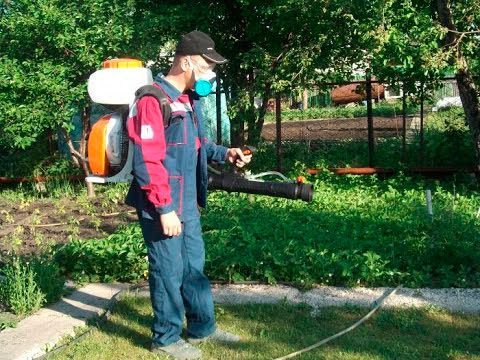

Ticks usually hide in tall grass, so after walking in a forest or field, be sure to do a self-examination for the presence of parasites. Try to wear closed clothes, no matter how hot it gets. Clothes should fit snugly to the body, sleeves should fit snugly around the wrist.
Wear a hat. Although ticks rarely rise to a height of more than one and a half meters and cannot fly, it is better to protect yourself, because you can bend over the first flower and pick up the pest from the nearest branch directly to your hair. Spray your clothes with a mite spray, since there is a great selection of them in stores. Do not spray chemicals intended for clothing on your skin!
Which ticks are the most dangerous and where do they live?
Not all types of ticks can be carriers of diseases that can harm humans. Representatives of the Ixodidae family are referred to as parasites on animals. This large group includes at least 700 species of ticks, they are distributed on all continents, even in Antarctica.
The most dangerous are three types of ticks of the ixodid family:
- Taiga.
- European forest.
- Pasture.
The first is located in the Asian part of Russia, and the second in the European. Both of these species have a body covered with a shell, have 4 pairs of legs. The body of females, due to the fact that they are able to consume more blood than the male, is equipped with a stretchable rear part.
The pasture mite is found in the southern zones, with long and hot summers. Usually attacks domestic animals, therefore, it poses a particular threat to people engaged in animal husbandry or often in contact with livestock.
Ixodids also like to live in grass and low bushes. Also, this type of bloodsucking loves wet, swampy places.
The most dangerous are:
- Banks of streams, rivers, and other bodies of water.
- Ravines.
- Deciduous and mixed forests.
Despite the fact that members of this family prefer places with high humidity, they are most active in sunny, dry weather. On a rainy day, it is much more difficult to fall prey to ticks.
Many Russians are not serious about tick bites
This is confirmed by another expert of the Center for Molecular Diagnostics of the Central Research Institute of Epidemiology of Rospotrebnadzor Mikhail Lebedev:
On the May holidays, ticks were found in almost all districts of the Moscow region, which means that they can be found in all parks of the capital.
The likelihood of catching a tick during the season remains in Moscow parks, and in the forests near Moscow, and in summer cottages.
In the Moscow region, there are places where you can check the tick that has bitten you.
It is necessary to remove the tick very carefully so as not to cut off the proboscis - during the period of suction, it becomes deeply strengthened. Observe the rules: grab the tick with tweezers or fingers wrapped in clean gauze as close as possible to its mouth apparatus and, holding strictly perpendicular to the bite surface, rotate it around its axis, remove it;
Observe the rules: grab the tick with tweezers or fingers wrapped in clean gauze as close as possible to its mouth apparatus and, holding strictly perpendicular to the bite surface, rotate it around its axis, remove it;
disinfect the bite site with any means: alcohol (70%), iodine (5%) or cologne; then wash your hands thoroughly with soap and water.
If a black dot remains on your body (the head or proboscis has come off), treat this place with iodine. Take the removed tick for research to the nearest laboratory.
What should I do if bitten by a tick?
If you are bitten by a tick in Moscow or the Moscow region or any other region, first of all, carefully remove it. If you have not been vaccinated, save the tick for further transfer for research. In Moscow, this point is located at Grafsky Lane, 4, Buildings 2, 3, 4 - "Center for Hygiene and Epidemiology in the City of Moscow"... If you receive a positive result from the laboratory, immediately contact a specialized medical institution in your region for treatment.
If you do not have the opportunity to take the tick for laboratory samples, or you have not saved it, get tested for antibodies two to four weeks after the bite.
Symptoms of infection with diseases borne by encephalitis ticks
The first symptoms of infection appear after a week or ten days, and if the body is weakened, then for 2-4 days. An infected person has a high temperature (up to 40 ° C), fever, aching joints and muscles, headache, general weakness, nausea, vomiting. The disease can end at this stage and the person recovers, or it can turn into a meningeal form when the virus infects the nervous system. The disease can progress further and lead to paralysis or death. The sooner treatment is started, the better the chances of a full recovery.
Tularimia affects the lymph nodes. The disease is characterized by: high temperature (up to 39 ° C), dizziness, nosebleeds, muscle pain, conjunctivitis. Lymph node tissue may be affected. Tularimia is dangerous with complications: meningitis, pulmonary abscess.
Lyme disease affects the brain, joints, lymph nodes, and the nervous system. Difficult to treat with antibiotics. Early symptoms are similar to the flu.
Common myths about ticks
Encephalitis is a very dangerous disease that will definitely cause disability or death. This is a common infection. Yes, it is acute, but with timely treatment, it usually does not leave any consequences.
You need to understand that encephalitis in Belarus and the Far East is a different type of virus. There the virus is more "evil", it infects the substance of the brain, and in our country - its membranes, like meningitis. Severe cases are extremely rare in Belarus.
It is important which part of the body the tick crawled into.... No, it doesn't matter. But the favorite places for ticks are where the skin is soft: behind the ear, armpits, groin, popliteal fossa, ankles, gluteal folds.
The more ticks bite you, the more severe the consequences will be. And again this is not true.If they are carriers of the same diseases, this will not affect the consequences. But in general, if you are disturbed by several ticks, the risk of mixed infections increases, and this is already quite dangerous.
The peak incidence occurs in the summer. Again a myth. In general, the season is the period from March to November. And the peaks are May and September. But much depends on the weather: warm and humid is considered favorable for ticks.
Reprinting of CityDog.by materials is possible only with the written permission of the publisher. Details here.
Troitsk - Russian "Fukushima"
The city used to please with large green areas, the once clean and bathing river Desna has already received another local name - Tukhlyanka. In it you can find shards of glass, experts have found there mercury and other impurities. The river has turned into an ecological disaster zone, dangerous for the population, flora and fauna. In Troitsk, there is a thermonuclear research center, which residents have nicknamed the Russian "Fukushima". In addition to it, there is a waste processing area, a nuclear reactor. The nearby Kaluzhskoe highway has a negative impact on the ecology of Troitsk.
In 2 km from the city, illegal garbage dumps have formed, where residents of cottage settlements bring it. These landfills sometimes have unpleasant odors in the air. Poor quality drinking water in the city, residents often complain about the admixture of sand and rust. Many trees have been cut down, the forest belt is polluted with waste.
IS IT DANGEROUS AND WHY?
Anti-mite treatment in the region is carried out by spraying grass and earth with a special substance. For this purpose, acaricides, which are rapidly degrading in the environment, are permitted in the country. According to experts, the product is safe for humans and warm-blooded inhabitants of the planet. Nevertheless, it is better to refrain from walking in parks during processing and for some time after it. Quarantine can last from one hour to several days. Residents in each municipality are required to notify in advance when processing will take place. Therefore, carefully follow the announcements on stands in parks or near the administration of the municipality, as well as on websites. They must warn you at least three days in advance.
If you do find yourself in a chemical treatment area, doctors recommend that you try to cover all exposed areas of your body and leave the park immediately. And then wash thoroughly under running water. This is usually enough to avoid an allergic reaction.
“If the first manifestations of allergy make themselves felt, then you should immediately contact a specialist dermatovenerologist or allergist-immunologist,” recommends Natalia Makhneva, chief freelance specialist in dermatology and cosmetology of the Ministry of Health of the Moscow Region. - It must be remembered that allergic reactions can occur even after a long time from the moment of contact with the chemical. This is due to some component of the product used to process the product, which is an important reason to visit a doctor.
IMPORTANT!
First of all, it is not recommended to visit parks during and after treatment for ticks for people suffering from bronchial asthma, as well as people prone to allergic reactions (rhinitis, conjunctivitis and dermatitis).
Where can you pick up a tick?
It is a mistake to believe that these blood-sucking animals live on tree branches. These arthropods usually attack people and animals from below.
They also prefer to hide in bushes and grasses, the height of which does not exceed half a meter. This is due to the fact that they do not like active movement.
The main areas where the bloodsucking is hiding:
- On low bushes.
- In the forest litter, namely in fallen leaves, needles.
- In the low grass.
- In vegetation near paths in parks and forests.
The last place attracts ticks by the fact that they smell the prey that periodically passes by.It should be noted that ticks do not have eyes and only rely on their scent when hunting.
Special organs responsible for the perception of odors are located on the legs of ticks. So, when walking in a park located within the city, you should also be careful.
When it is on the leaves of trees or grass, the tick spreads its legs out so that, with a light touch, it immediately catches on to a person. Also, a tick can "stick" to a person's clothes, shoes, and then crawl up, in search of the most convenient place for a bite. On average, a tick is on a person for about 30 minutes, only looking for the right point on the skin.
Often these blood-sucking people settle down on people who sit on the ground or grass. In this case, individuals of the tick simply crawl onto the person.
Despite popular belief, these arthropods do not jump on humans. This erroneous judgment is due to the fact that ticks, rising from below, can crawl up to the neck unnoticed.
